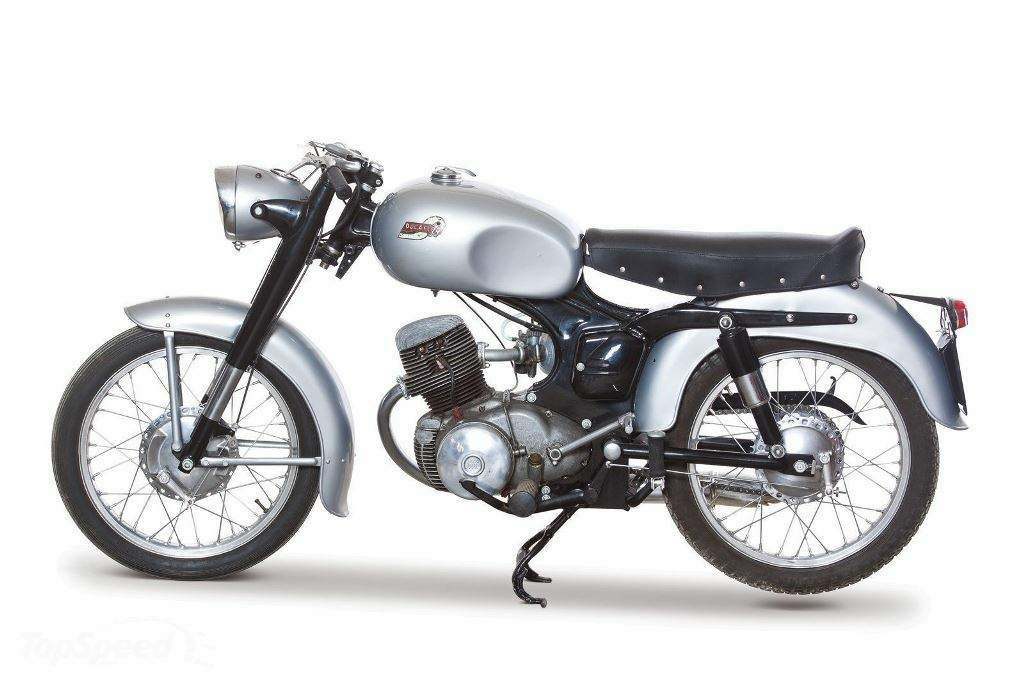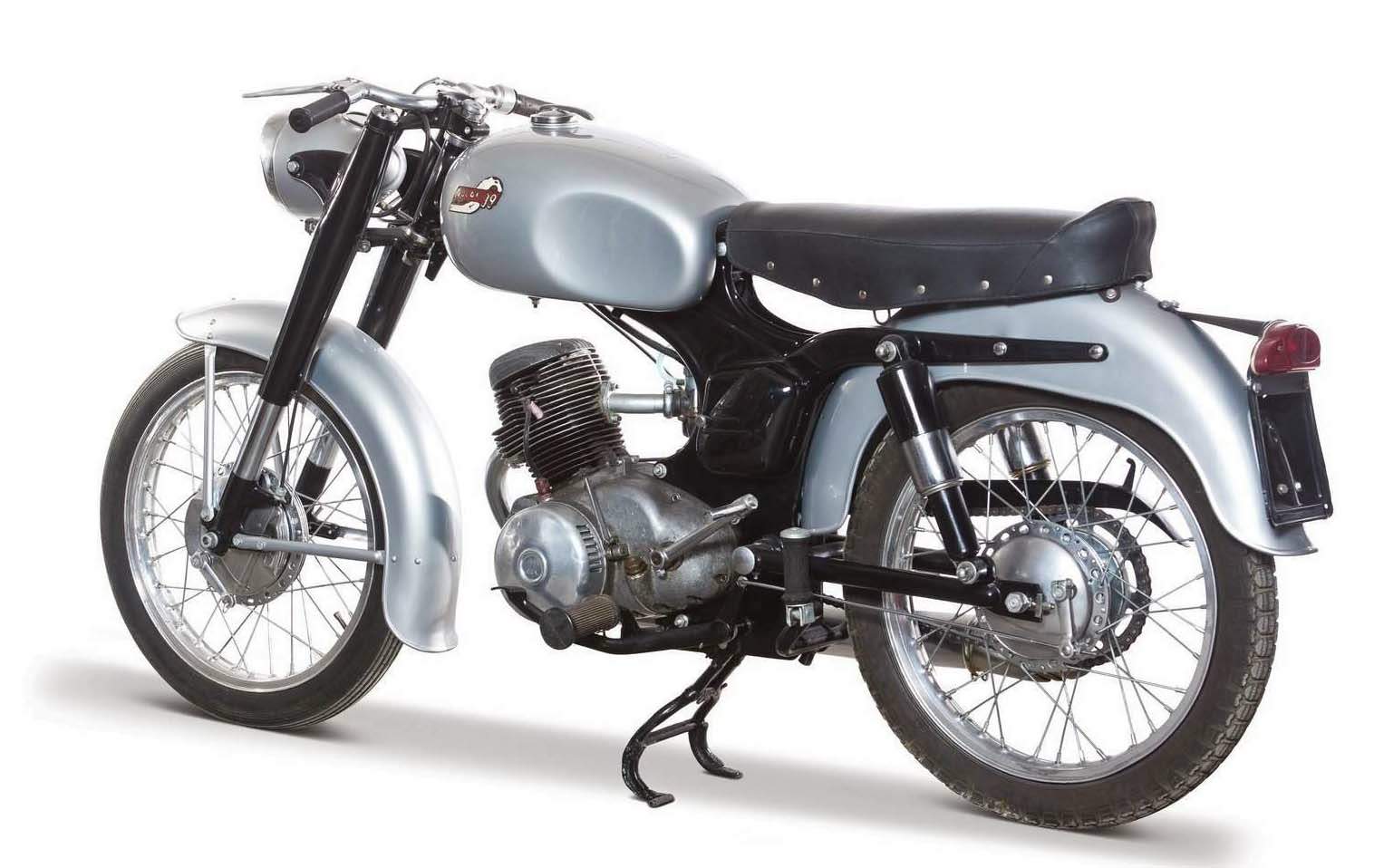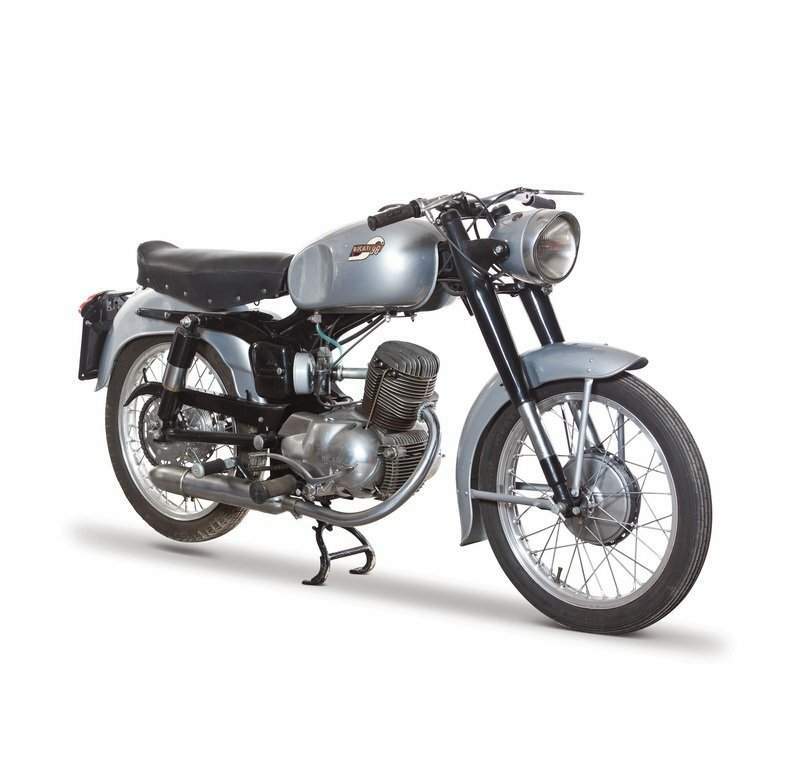
|
|
|
|
|
|
Classic Bikes
Custom Bikes
Individual
Racing Bikes AJP
AJS
Aprilia
Ariel
Avinton / Wakan
Bajaj
Benelli
Beta
Bimota
BMW
Brough Superior
BRP Cam-Am
BSA
Buell / EBR
Bultaco
Cagiva
Campagna
CCM
CF Moto
Combat Motors
Derbi
Deus
Ducati
Excelsior
GASGAS
Ghezzi Brian
Gilera
GIMA
Harley Davidson
Hero
Highland
Honda
Horex
Husaberg
Husqvarna
Hyosung
Indian
Jawa
Kawasaki
KTM
KYMCO
Laverda
Lazareth
Magni
Maico
Mash
Matchless
Mondial
Moto Guzzi
Moto Morini
MV Agusta
MZ / MuZ
NCR
Norton
NSU
Paton
Peugeot
Piaggio
Revival Cycles
Roland Sands
Royal Enfield
Sachs
Sherco
Sunbeam
Suzuki
SWM
SYM
Triumph
TVS
Ural
Velocette
Vespa
Victory
Vincent
VOR
Voxan
Vyrus
Walt Siegl
Walz
Wrenchmonkees
Wunderlich
XTR / Radical
Yamaha
Zero
Video
Technical
Complete Manufacturer List
|
Ducati 98 Sport / SS
|
| . |
|
Make Model |
Ducati 98 Sport / SS |
|
Year |
Sport: 1953 - 58 SS: 1954 - 55 |
|
Engine |
Four stroke, single cylinder, OHV, pushrod |
|
Capacity |
98 cc / 6.0 cu in |
| Bore x Stroke | 49 x 52 mm |
| Compression Ratio |
Sport: 9:1 SS: 10:1 |
|
Cooling System |
Air cooled |
|
Lubrication System |
Dry sump |
|
Induction |
Sport: Dell' Orto MA18B carburetor SS: Dell' Orto MB20B carburetor |
|
Ignition |
6V, 25W, Flywheel magneto |
|
Starting |
Kick |
|
Max Power |
1953 - 54: 5.0 kW / 6.8 hp @ 7300 rpm 1955 - 58: 4.8 kW / 6.5 hp @ 7000 rpm |
|
Transmission |
4 Speed |
|
Final Drive |
Chain |
| Primary Drive | 3.454 |
| Gear Ratios | 1st 2.69 / 2nd 1.85 / 3rd 1.36 / 4th 1:1 |
| Final Drive | 2.706 |
| Frame | Pressed steel backbone |
|
Front Suspension |
Marzocchi hydraulically damped telescopic fork. |
|
Rear Suspension |
Non-adjustable twin hydraulic shocks, swingarm. |
|
Front Brakes |
159 mm Drum |
|
Rear Brakes |
137 mm Drum |
|
Front Tyre |
2.50 - 17 CEAT |
|
Rear Tyre |
2.75 - 17 CEAT |
|
Dimensions |
Length: 1890 mm / 74 in Width: 660 mm / 26 in Height: 960 mm / 38 in |
|
Wheelbase |
1200 mm / 47.2 in |
|
Seat Height |
760 mm / 30 in |
|
Dry Weight |
75 kg / 165 lbs |
|
Wet Weight |
81 kg / 179 lbs |
|
Fuel Capacity |
13 L / 3.7 US gal / 3.1 Imp gal |
|
Top Speed |
Sport: 90 km/h / 56 mph SS: 95 km/h / 59 mph |

Designed by newly arrived engineer, Fabio Taglioni, formerly with Mondial,
Ducati's first overhead-camshaft single - the 100 Gran Sport, nicknamed
'Marianna' - appeared on the racetrack in 1955 and immediately proved unbeatable
in its class. The Gran Sport's overhead cam was driven by a vertical shaft and
bevel gears, and this method was carried over to Ducati's twin-cam (bialbero)
and triple-cam (trialbero) racers, the latter featuring Taglioni's famous
'desmodromic' method of valve actuation that dispensed with springs.
Incorporating a four-speed gearbox, the Gran Sport engine was carried in a
simple single-downtube frame and acted as a stressed member.
Capitalising on the Gran Sport's successes, Ducati introduced further
developments of Taglioni's racer in 125 and 175cc capacities, while at the same
time adapting it for volume production. This 'civilising' process involved
enclosing the valve springs and using helical rather than straight-cut gears for
the bevel drive, while to keep costs down, the crankcases were now die-cast.
Otherwise, the design remained faithful to the original Gran Sport concept. The
first such roadster - the 175 Sport - appeared towards the end of 1956, with
175T, 125 Sport, and 100 Sport versions following soon afterwards.
Apart from the Italian Grand Prix, the most important motorcycle races in Italy
at this time were the long-distance events, held on public roads, such at the
Moto Giro d'Italia and Milan-Taranto. Hence even competition-orientated models
like the Marianna had to have lights and a horn, as required by the FMI (Italian
Motorcycle Federation) regulations. Almost all the Italian manufacturers
contested these events, victory bringing with it much valuable publicity.
Ducati's overhead-valve racers had been outclassed by the Laverdas in 1954, but
from the time of its arrival the Marianna proved unbeatable in its class.
Built in 1953 to join the ranks of the Ducati 98 N and the Ducati 98 T OHV, the 98 Sport became an immediate success in the market, despite its modest performance capabilities. At the heart of the Ducati 98 Sport is a 98 cc OHV single cylinder engine that’s been mated to a four-speed transmission. The powertrain was capable of producing 6.8 horsepower with a top speed of 56 mph. Those numbers may not mean much compared to the bikes Ducati has in its line-up today, but back then, that was enough to make the 98 Sport one of the most popular bikes the company’s range.


|
Any corrections or more information on these motorcycles will be kindly appreciated. |